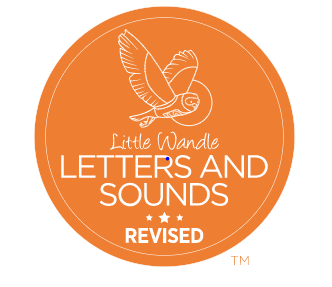Phonics

At Shirley Infant School we give a high priority to the teaching of phonics, and we teach phonics daily across the school. We adopt a systematic synthetic phonics approach through the 'Little Wandle Letters and Sounds Revised' programme. The approach teaches children to recognise letters (graphemes) and their associated sounds (phonemes). The scheme teaches the sounds in an order which allows them to quickly begin to blend sounds together to read words. When we first teach the letter sounds to the children, we teach the pronunciation phrase alongside introducing the grapheme, mnemonic and picture card for each sound. Alongside the skills of blending (putting sounds together to read) and segmenting (breaking words down to spell them), the children are also taught exception words that cannot be sounded out, such as 'was' or 'me'. We call these words 'tricky words' and they learn to read and to spell these from memory within each phase.
The Year R phonics curriculum teaches children the first letter sounds in manageable groups, based on the Little Wandle Letters and Sounds programme. Children are then taught to read and then write simple words using these sounds. Below is a copy of the programme overview we follow in school:
Here are some handy guides to show you how the children are taught to say and write the sounds in Reception:
Pronunciation guide Phase 2 Autumn 1
Pronunciation guide Phase 2 Autumn 2
The children in Year 1 continue with daily phonics practice, following the Little Wandle Letters and Sounds programme. The national phonics screen is taken by all children in Year 1 during a specified week in June. Any children who did not take the test or did not pass the test in year 1 will retake it again in year 2.
Here is a handy guide to show you how the children learn the alternative graphemes for sounds introduced in Phase 2 and 3:
More information can be found here:
https://www.littlewandlelettersandsounds.org.uk/resources/for-parents/
The children in Year 2 continue to follow the Letters and Sounds programme and the main focus is on supporting children’s spelling strategies. Children will be taught the many rules for spelling plurals, and adding prefixes and suffixes to words.
A list of the Year 2 spelling rules can be found here:
Spelling
Click on this link to watch a video about how we teach spelling from Year R to Year 2.
When teaching the children to spell, we encourage the children to segment the word into separate phonemes e.g. c-l-a-p. From Early Years the children learn different graphemes for the phonemes, e.g. when spelling luck, they might use 'c' for cat, 'k' for kitten or 'ck' for duck. When children begin to write words, we encourage the children to 'Ask the Question'. e.g. when spelling 'cup' they ask 'Is it 'c' for cat, 'k' for kitten or 'ck' for duck. When children become more confident spellings, we encourage children to begin to look at the likely position of the word, e.g. 'ck' usually comes at the end of the word.
When children enter into year 1 they learn lots of alternative graphemes, e.g -ay and a-e can also be used when spelling words with the -ai sound. We continue to encourage children to 'Ask the question', e.g. when spelling -drain is it -ai for snail, ay for play or a-e for cake. We teach children the most likely positions for words. They then learn alternative pronunciations for words, e.g. in cow and blow, the ow is pronounced differently. In year 2 children continue to embed this learning and increase their accuracy spelling new words. They learn the different principles for adding suffixes to root words, e.g. when spelling hopped, you double the p in hop and then add -ed.
Reading and early phonics are instrumental and work closely together to ensure our children develop secure reading skills.
Lots of parents always worry about to pronounce the letter sounds. Click on these links to help you:
https://www.youtube.com/watch?v=TTe5_Em0BHQ
https://www.littlewandlelettersandsounds.org.uk/resources/for-parents/
Useful Phonics Websites for Parents and Children
This video models the skill of blending sounds together:
This website explains the background to our theory in early phonics and reading: https://www.youtube.com/watch?v=u8C8BCB4hvc
There are also a wealth of websites with games which could support your child's progress in phonics...
This website has lots of free games that are useful for blending to read and is also useful for deciding whether word is real or nonsense: http://www.phonicsplay.co.uk/InteractiveResources.htm
This is a reading game where the children read a question and have to click on yes or no. The level can be adjusted for easier or trickier words: http://www.ictgames.com/tellAtRex_v3.html
This game allows you to input your own words to practise reading. So if you are practising a particular sound like 'ch', you can type in all 'ch' words: http://www.ictgames.com/helpAHedgehog/index.html
This game practises the sounds individually. You have to pop the balloons with the given sound: http://www.ictgames.com/phonemeFlop_v4.html
Also remember that your child has an individual log in to the Education City website, which we regularly use in school.
